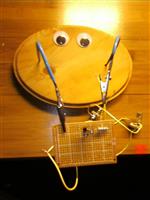
Hi folks.
When routing QFPs, I tend to route "out" parallel with the pads. I avoid routing at 90 degrees to them.
There's a practical reason for this - Let's say I connect two adjacent pins directly with a track.
I've had PCBs come in with no soldermask between QFP pins, soldered them up, and thought I had a solder bridge between two pins. So I spend several minutes with solder wick trying valiantly to clean that up... only to get the microscope out find there's a track between them. So these days, I 'dogleg' the track out far enough that it exits into the solder mask, then connect it to its neighbour.
I've seen a few PCB standards guides which say much the same: "QFP tracks must exit parallel with the long edge of the pad. If the pad is square, they must exit parallel with the long edge of the pin, i.e. in parallel with the direction the pin takes when exiting the component body." (I can quote this almost from memory - it's from a previous employer).
But here's a slightly different scenario.
I have a chip with power pins on its corners. This is actually a pretty sweet deal, because I can chuck the decoupling capacitors in the corners out of the way, and everything routes out nicely. Beautiful.
Question is, is there anything actually wrong with having the traces leave at 90 degrees to the pad?
I've attached a screenshot showing what I'm talking about.
I'm aware of the old reasons, acid traps and under-etching (which is why we have those nice 45-degree bends); is this still a big deal with modern etching processes?
- Comments(1)
A****min
Aug 01.2019, 17:42:42
That's totally fine. Minimise the inductance in series with your decoupling caps; don't waste time or worsen the electrical characteristics of your layout just to make it look 'nice'.


